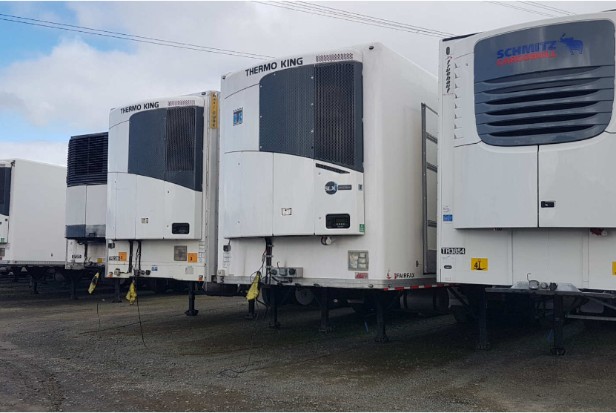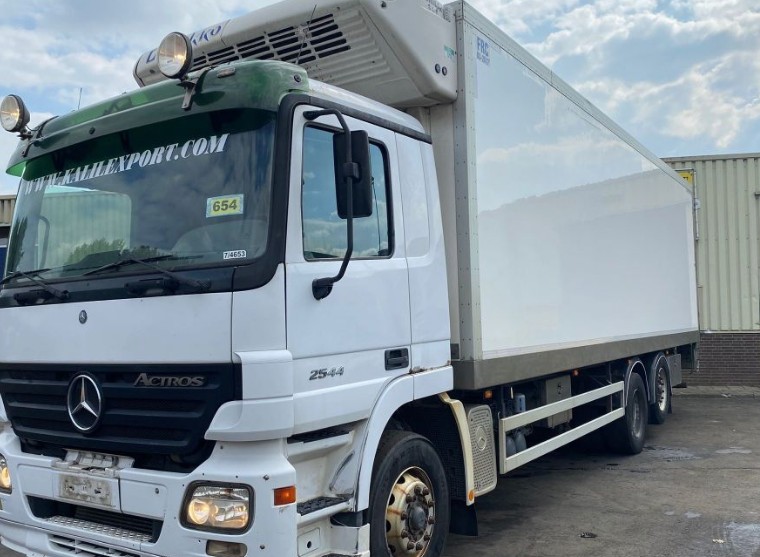
What Is A Reefer Truck – Pros & Cons
In trucking, a “reefer” is a refrigerated trailer that gets attached to a semi-truck in order to transport perishables and other temperature-sensitive goods. Around 1925, the ice cream industry was the original creator of the reefer. Heated goods may also be transported in reefers.
What Maintains The Cool Of A Reefer Container?
Reefer units utilize closed systems to pump, remove, and collect heat in order to maintain a constant temperature. Cooling for a reefer container is achieved through different methods, which can include:
- Diesel-powered generators: These attach to the container being pulled
- Cryogenic cooling: Melts frozen carbon dioxide ice to keep contents cool
What Is The Procedure For Refrigerated Trucking?
Similar to conventional semi-trucks, reefer trucks transport cargo and perishable goods that need temperature-controlled environments. Reefers have insulation and interior vents that preserve the condition of these resources.
When compared to dry van trucks, reefers offer both of these benefits, which are substantial advantages. Reefers, as opposed to cooling vans, have active cooling systems that enable the transportation of frozen and refrigerated freight.
The compressor on reefer trucks is powered by a small diesel engine. In turn, the gaseous refrigerant experiences a pulling effect. This procedure liquefies the gas, which then heats the compressor’s body, raising the truck’s interior temperature. Similar to how radiators cool engines, this heat exchange takes place in the condenser.
Even after losing the majority of its heat to the condenser, the liquefied gas is still under pressure. The pressurized liquid is forced into the evaporator by the condenser, where it cools. How much refrigerant the evaporator receives is managed by a metering valve.
The evaporator always contains a second rapidly expanding refrigerant. It absorbs a lot of heat from the surroundings as a result of its expansion, which turns it into a gas. The interior air of the trailer will flow into the evaporator and then into the compressor. Technically, it’s a cycle that repeats itself.
The cooling effect this process creates in the van helps to maintain the refrigeration of the materials being transported at all times. To ensure that the cargo in a reefer truck remains in perfect condition during transport, precoolers are typically used to store the cargo before it is shipped.
Parts Of A Reefer Truck Or Trailer
Reefer trailers and trucks use active cooling rather than passive cooling. Instead of depending on insulated panels to maintain a product at a specific temperature for 96 hours or longer, they use battery- or electric-powered generators to keep goods at a constant temperature and humidity.
Compressor, condenser, evaporator, and insulation are among the components of a reefer trailer.
- Compressor: The compressor on a truck unit frequently fastens to the engine and powers the entire unit by bringing in and compressing gaseous refrigerant using a small motor or vehicle belt system. The gas is a cool, low-pressure fluid that enters the system and leaves as a high-pressure, hot gas.
- Condenser: The high-pressure gas loses heat through a fan-based cooling system after going through condenser coils after going through the compressor. As soon as enough heat is taken in by the condenser from the cargo section, it is used to create gas. Due to pressure, the gas inside the condenser condenses and liquidizes, resulting in a high-pressure, regular-temperature liquid.
- Expansion valve: The expansion valve controls the flow of refrigerant throughout the system, which is essential to the reefer container truck process. A low-pressure, cold liquid is produced when the valve restricts the flow of the refrigerant.
- Evaporator: The evaporator, which is housed in the truck’s cargo area, converts the cold, low-pressure liquid into a low-pressure, low-temperature gas. The air circulates throughout the trailer by being drawn at room temperature from the cargo area and passing over the evaporator coils and fins. Due to its low boiling point, refrigerant passing through the evaporator will boil and turn into a gas. The process is then repeated with the gas as it flows back to the compressor until the system reaches the desired temperature.
- Insulation: The interior of the truck is shielded from the outside environment by a layer of polyurethane foam that covers the entire trailer.
What Constitutes A Reefer Unit, Exactly?
Maintaining a constant temperature for the goods being transported is the purpose of a reefer unit. For instance, if ice cream must be kept at – 40°F, the reefer unit’s parts will make sure it gets to its destination at the same temperature as when it was loaded.
This is all a part of cold chain logistics, which is the technology and procedure enabling the secure transportation of temperature-sensitive goods throughout the supply chain. What then causes the reefer trailer to operate as it should? Components of a reefer unit include:
- The compressor: A small engine powers the compressor, which draws in and compresses gaseous refrigerant to liquefy it and release heat.
- The condenser: The liquid from the compressor is transferred to the condenser for heat exchange, filling the tubing all the way to the attached fins. Similar to how radiators function, these fins assist in cooling the outside air that passes through the condenser.
- The evaporator: The metering valve of the trailer’s evaporator, which regulates cooling, receives the liquid after it has cooled. As it grows and turns back into a liquid, the refrigerant absorbs heat from the finned coils all around it. The compressor is used to restart the cooling cycle after the evaporator is exposed to the cooled air inside the trailer.
How Long Is The Life Of A Reefer Trailer?
The average reefer has a lifespan of over 40,000 hours, or eight years. If you take good care of your truck, you can extend the life of your reefer trailer.
Will My Reefer Work As A Dry Van?
Reefers can function both as dry vans and refrigerated trucks. Despite having a cooling system, these trucks can transport heated items. The flexibility of reefers is greater than that of pure dry vans, though.
What Sort Of Goods Are Shipped In Refrigerated Trailers?
Temperature-sensitive cargo is stored in refrigerated trailers. Reefers are best for certain types of freight, including the following:
- Bulk liquids
- Flowers
- Hazardous materials
- Chewing gums
- Paint
- Pharmaceuticals
When Should A Reefer Be Run Continuously?
When traveling through warm climates, it is best to keep your reefer running continuously. Running your reefer continuously will shield the cargo from the effects of the heat.
Which Truck Type—Dry Van Or Reefer—Is The Most Advantageous?
The shipping method that best meets your transportation needs must be chosen before you can successfully transport freight. Dry van trucks and reefer trucks are the two most popular types of the many options available to you. Each mode of transportation has unique qualities, benefits, and drawbacks that affect both shippers and carriers who move freight.
A dry van or a box trailer is typically a type of semi-trailer that is completely enclosed to protect freight from the elements. They are the trailers attached to trucks that you frequently see on the road.
They are typically large, rectangular boxes that can hold boxed, palletized, loose freight, or any other kind of machinery. They cannot accept oversized or bulky shipments, and they are not temperature-controlled, unlike refrigerated reefer units.
Dry vans are useful for both full truckload and less-than-truckload (LTL) shipments and have a number of advantages. The majority of the shipped goods you are receiving most likely traveled on a dry van.
For full-truckload and LTL shipments, the majority of shippers use them. While you can plan specific pick-up and delivery times for full truckload shipments, choosing LTL shipments can save you money because of freight consolidation.

Example Of Reefer Trucking
To serve their patrons, restaurants require perishable food and fresh ingredients. Food kept in a dry van would be unusable when it arrived. Restaurants use reefer trucks to transport their deliverables in order to preserve their goods and maintain compliance with food safety standards.
Things To Consider With Reefer Trucks
For business owners who frequently need to receive items that are sensitive to temperature, reefers will come to their rescue. Using reefers allows truckers and their drivers to reach a wider range of potential clients, which boosts sales. Before purchasing or renting refrigerated trucks, you should take into account the following factors.
Food Safety Training Requirements
Reefer trucks must comply with training standards for food safety in order to be used safely and effectively. Drivers of reefer trucks must not only be aware of the temperature requirements for moving food, but also be able to maintain those conditions.
The Sanitary Transportation of Human and Animal Food is covered by a rule made by the US Food and Drug Administration. This was done in an effort to stop the spread of contaminated food. These procedures can guarantee that food-transportation trailers and vehicles are properly refrigerated and sanitized.
Before choosing a reefer trailer, you must give the requirements for food safety training top priority. The prerequisites for food and safety training for drivers of reefer trucks are listed below.
- Equipment: All of the transportation equipment, including the vehicle itself, must be thoroughly cleaned. Additionally, the temperatures that are deemed safe for the transportation of food must be maintained for this equipment.
- Operations: This includes the steps taken to guarantee that food safety standards are upheld during transportation, such as temperature controls, food contamination prevention, and various other factors. Prior to loading, a refrigerated trailer should be thoroughly cleaned to remove any potential contamination from prior loads.
- Training: Truck drivers who are subject to the FSMA’s Sanitary Transportation of Human and Animal Food Rule may take advantage of a free training module provided by the FDA. You will be in the best possible position to serve your customers if you take the course.
- Records: Records of contracts, training, and written policies must typically be kept for at least a year by drivers and trucking companies.
Motor Operations
Before buying, find out how the reefer truck functions. When unloading, loading, and in other situations when you are not actively driving on the road, reefer vehicles’ main engines must stay running. Make sure your operations require extra power for the truck’s refrigerator before selecting a reefer truck.
Disadvantages Of Reefer Trucking
Even though reefer trucking might have a few advantages, you should be aware of these drawbacks. Before making any investments, drivers should understand the benefits and drawbacks.
Now, here is a list of some of the disadvantages of reefer trucking:
- Can be noisy
- Longer waiting time for unloading and loading at shipping docks
- Unavoidable product damages
- Not suitable for long-haul shipping
Reefer Vs Dry Van Trucking
Truck drivers must choose the best shipping options for their needs. Despite having a wide range of options, reefers and dry van trucks are frequently chosen by truck drivers.
In contrast to reefer trucking, which uses temperature-controlled semi-trucks to transport perishable and temperature-sensitive goods, dry van trucking employs fully enclosed semi-trailers. These semi-trailers are then used to transport loose, boxed, or freight on pallets. A reefer can transport dry cargo, but it cannot transport temperature-sensitive items.
Expand Your Choices With Reefer Trucking
Reefer trucking gives drivers another career option while assisting trucking companies in serving more clients. Due to the large number of temperature-sensitive goods that must be transported, the supply chain has a constant need for refrigerated truck transportation. By purchasing these trucks, you can profit from emerging market opportunities.



Average Rating